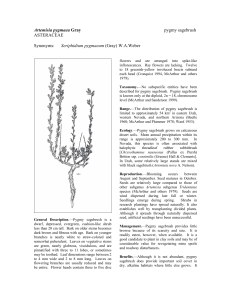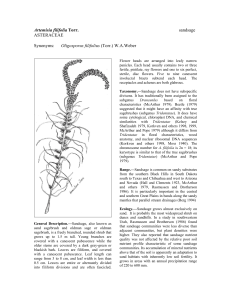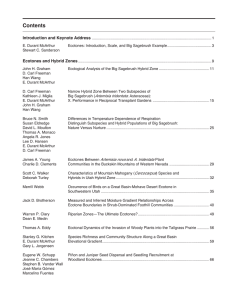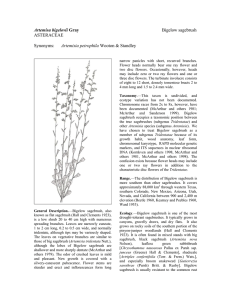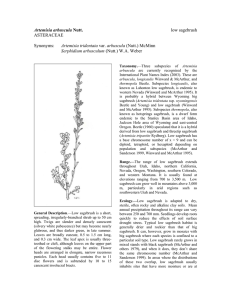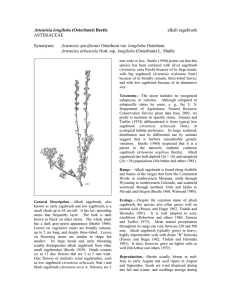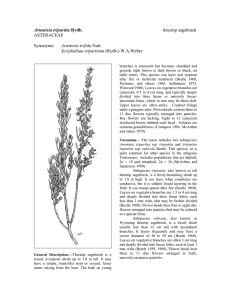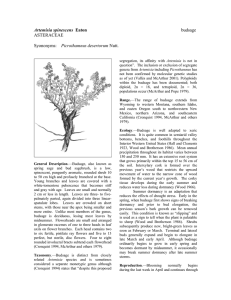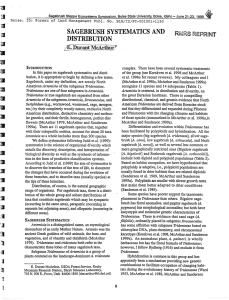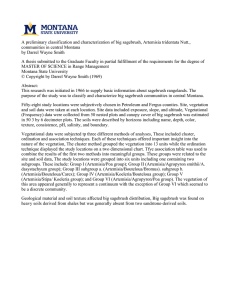Artemisia rigida sagebrush ASTERACEAE
advertisement
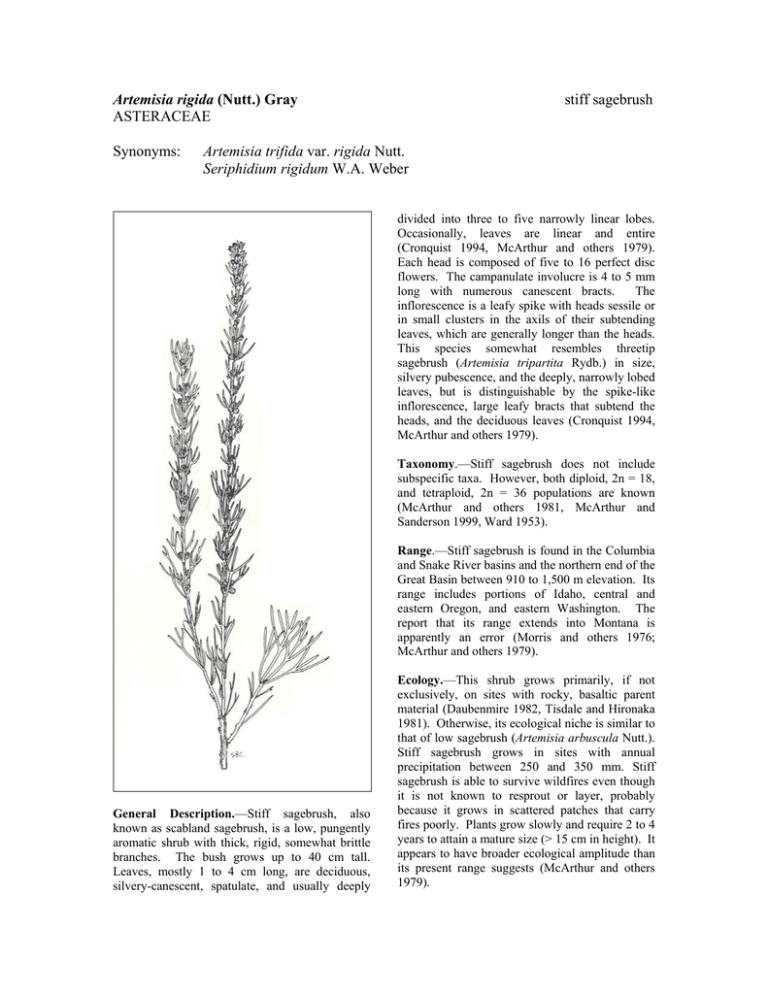
Artemisia rigida (Nutt.) Gray ASTERACEAE Synonyms: stiff sagebrush Artemisia trifida var. rigida Nutt. Seriphidium rigidum W.A. Weber divided into three to five narrowly linear lobes. Occasionally, leaves are linear and entire (Cronquist 1994, McArthur and others 1979). Each head is composed of five to 16 perfect disc flowers. The campanulate involucre is 4 to 5 mm long with numerous canescent bracts. The inflorescence is a leafy spike with heads sessile or in small clusters in the axils of their subtending leaves, which are generally longer than the heads. This species somewhat resembles threetip sagebrush (Artemisia tripartita Rydb.) in size, silvery pubescence, and the deeply, narrowly lobed leaves, but is distinguishable by the spike-like inflorescence, large leafy bracts that subtend the heads, and the deciduous leaves (Cronquist 1994, McArthur and others 1979). Taxonomy.—Stiff sagebrush does not include subspecific taxa. However, both diploid, 2n = 18, and tetraploid, 2n = 36 populations are known (McArthur and others 1981, McArthur and Sanderson 1999, Ward 1953). Range.—Stiff sagebrush is found in the Columbia and Snake River basins and the northern end of the Great Basin between 910 to 1,500 m elevation. Its range includes portions of Idaho, central and eastern Oregon, and eastern Washington. The report that its range extends into Montana is apparently an error (Morris and others 1976; McArthur and others 1979). General Description.—Stiff sagebrush, also known as scabland sagebrush, is a low, pungently aromatic shrub with thick, rigid, somewhat brittle branches. The bush grows up to 40 cm tall. Leaves, mostly 1 to 4 cm long, are deciduous, silvery-canescent, spatulate, and usually deeply Ecology.—This shrub grows primarily, if not exclusively, on sites with rocky, basaltic parent material (Daubenmire 1982, Tisdale and Hironaka 1981). Otherwise, its ecological niche is similar to that of low sagebrush (Artemisia arbuscula Nutt.). Stiff sagebrush grows in sites with annual precipitation between 250 and 350 mm. Stiff sagebrush is able to survive wildfires even though it is not known to resprout or layer, probably because it grows in scattered patches that carry fires poorly. Plants grow slowly and require 2 to 4 years to attain a mature size (> 15 cm in height). It appears to have broader ecological amplitude than its present range suggests (McArthur and others 1979). Reproduction.—Blooming begins in late August and ends in early October, and seeds ripen in October and November. Seed is wind dispersed in late fall or winter, and seedlings emerge during the ensuing spring. Seed production and seed quality are low in comparison to other sagebrush species (McArthur and others 1979). Attempts to seed and transplant this species in arid sagebrush ranges near Boise, Idaho, have been unsuccessful. In such instances, plantings were made where cheatgrass (Bromus tectorum L.) and other annuals have invaded, and stiff sagebrush seedlings were unable to compete. Plantings have successfully established on prepared seedbeds, however. Management.—Due to scant foliage and stiff branches, few animals except domestic sheep browse stiff sagebrush (Hall and Clements 1923). It provides forage on dry sites for domestic sheep during midsummer when herbaceous plants are dry. Benefits.—Stiff sagebrush is a native shrub that adds biological diversity to Western ecosystems. It is an important plant that provides cover and reduces erosion on rocky sites. Its ecology suggests that it could be used in reclaiming harsh, disturbed sites. McArthur, E.D., C.L. Pope, and D.C. Freeman. 1981. Chromosomal studies of subgenus Tridentatae of Artemisia: evidence for autopolyploidy. American Journal of Botany 68: 589-605 McArthur, E.D. and S.C. Sanderson. 1999. Cytogeography and chromosome evolution of subgenus Tridentatae of Artemisia (Asteraceae). American Journal of Botany 86: 1754-1775. Morris, M.S., R.G. Kelsey, and D. Griggs. 1976. The geographic and ecological distribution of big sagebrush and other woody Artemisias in Montana. Proceedings Montana Academy of Sciences 36: 56-79. Tisdale, E.W. and M. Hironaka. 1981. The sagebrush-grass region: a review of the ecological literature. Bulletin no. 33. University of Idaho, College of Forestry, Wildlife and Range Sciences, Forest, Wildlife and Range Experiment Station, Moscow, ID. 31 p. Ward, G.H. 1953. Artemisia, section Seriphicum, in North America. A cytotaxonomic study. Contributions from the Dudley Herbarium 4: 155-205. _________________________________________ References Cronquist, A. 1994. Asterales, Intermountain flora, volume 5. The New York Botanical Garden, Bronx, NY. 496 p. Daubenmire, R. 1982. The distribution of Artemisia rigidia in Washington: a challenge to ecology and geology. Northwest Science 56: 162-164. Hall, H.M. and F.E. Clements. 1923. The phylogenetic method in taxonomy; the North American species of Artemisia, Chrysothamnus, and Atriplex. Publication 326. Carnegie Institution of Washington, Washington, DC. 355 p. McArthur, E.D., A.C. Blauer, A.P. Plummer, and R. Stevens 1979. Characteristics and hybridization of important intermountain shrubs. III. Sunflower family. Research Paper INT-220. U.S. Department of Agriculture, Forest Service USDA Forest Service, Intermountain Forest and Range Experiment Station, Ogden, UT. 82 p. E. Durant McArthur and Jeffrey R. Taylor, Research Geneticist and Biological Technician, U. S. Department of Agriculture, Forest Service, Rocky Mountain Research Station, Shrub Sciences Laboratory, Provo, UT 84606-1856
